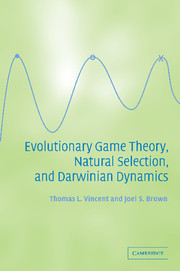Book contents
- Frontmatter
- Contents
- List of figures
- Preface
- 1 Understanding natural selection
- 2 Underlying mathematics and philosophy
- 3 The Darwinian game
- 4 G-functions for the Darwinian game
- 5 Darwinian dynamics
- 6 Evolutionarily stable strategies
- 7 The ESS maximum principle
- 8 Speciation and extinction
- 9 Matrix games
- 10 Evolutionary ecology
- 11 Managing evolving systems
- References
- Index
8 - Speciation and extinction
Published online by Cambridge University Press: 11 August 2009
- Frontmatter
- Contents
- List of figures
- Preface
- 1 Understanding natural selection
- 2 Underlying mathematics and philosophy
- 3 The Darwinian game
- 4 G-functions for the Darwinian game
- 5 Darwinian dynamics
- 6 Evolutionarily stable strategies
- 7 The ESS maximum principle
- 8 Speciation and extinction
- 9 Matrix games
- 10 Evolutionary ecology
- 11 Managing evolving systems
- References
- Index
Summary
The identity of plants and animals rendered by pre-historic artists in cave paintings, rock art, and sculpture is usually recognizable. With the development of language, plants and animals were given names, but a systematic categorization arose more recently when Carl Linnaeus introduced the idea of species as a binomial nomenclature of grouping organisms by genus and species. These early forms of pictorial, vernacular, and formal means of identifying groups of animals and plants were unaltered by later knowledge of evolution and phylogeny. Categorization simply recognizes the following three obvious properties of nature.
First, individuals (like matter in the universe) tend to be clumped rather than randomly or uniformly spread across the space of all imaginable morphologies, physiologies, and behaviors. This clumping of individuals around discrete types can to us be conspicuous – it's hard to misidentify an elephant. However, for some species, it can be really tricky. For example, both humans and male hummingbirds find it nigh impossible to distinguish the species identity of certain female hummingbirds. But, whether tightly clumped (as a planet or asteroid) or only vaguely clumped (more nebula-like), individuals can and seem to be naturally ordered as discrete kinds.
Second, long before Darwin, heritability was recognized by the fact that kinds tended to breed among themselves (assortative mating). Assortative mating can be socially or geographically imposed, or it can be due to physical constraints (elephants and hummingbirds cannot breed in any circumstance). Of course, hybrids occur; yet the very concept of a “hybrid” implies that organisms can be grouped by heritable characteristics and that crossings between groups produce novel, yet predictable, mixes of heritable traits.
[…]
Information
- Type
- Chapter
- Information
- Publisher: Cambridge University PressPrint publication year: 2005
